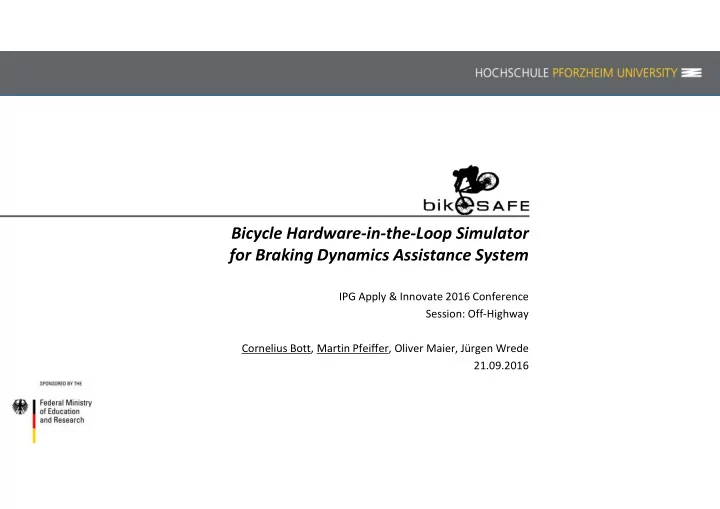

Bicycle Hardware ‐ in ‐ the ‐ Loop Simulator for Braking Dynamics Assistance System IPG Apply & Innovate 2016 Conference Session: Off ‐ Highway Cornelius Bott, Martin Pfeiffer, Oliver Maier, Jürgen Wrede 21.09.2016
Outline Introduction to BikeSafe Motivation Vision Methodology HIL Testbench Structure and Components Usage in Development Results Conclusion 2
Motivation for Active Safety Systems on Bicycles Front wheel lockup • Low wheel moment of inertia Bicycle braking • Risk of overbraking systems Electrified • Mainly on roads with low • Properly adjusted: bicycles friction coefficient & in curves always very powerful • Modern hydraulic technology: • Availability of electric energy Nose over stronger and more robust • Favourable mass & cost ratio (falling over the handlebars) • High risk of falling due to • High centre of gravity users’ mistakes • Emergency or shock braking • Mainly on roads with high friction coefficient & downhill 3 Sources: Gustav Magenwirth GmbH, Robert Bosch GmbH
Vision Functional Prototype Actuator • Purpose: brake pressure modulation • Hydraulic unit of motorcycle ABS Control unit • Purpose: algorithm development • Rapid ‐ control ‐ prototyping system Sensors • Measurand: front wheel speed • Active sensor based on Hall Effect • Measurands: 1) longitudinal and vertical accelerations 2) pitch rate • Micromechanical sensor unit 4
Mechatronic Structure of the Braking Dynamics Assistance System (BDA) Driver Environment u D z u y x r Controller Actuators Plant Sensors 5
Methodology of Development Requirements Profile Proof of Concept ① ⑤ Validation Accident research and Functional model respective applications evaluation ② ④ Validation Requirements System integration identification and and testing quantification ③ System design and implementation 6
Structure of HiL ‐ Testbench Xeno Realtime ‐ User ‐ PC Computer Parameters, Stimuli Measurement Values Simulation Bicycle CarMaker Model Measurement Sensor Signals BDA ‐ Values Experiment Function I/O Modules Measure ‐ Brake ment Actuation Hardware ‐ Values dSPACE MAB Installation Brake System Bosch Hydraulic Pneumatic Control Brake HU System 7 Signals HU
Simulation Model Equation ‐ based Physical Multi ‐ Body 4 DoF 13 DoF Model with three Model Bodies Software: Simulink Software: SimHydraulics/ SimMechanics Features: Extensions: Static effects of hydraulic brake system Dynamic effects of brake hydraulic Plain movement (longitudinal and vertical) Repeated rear ‐ wheel lift ‐ off Driver is modeled as a point mass Movement of driver during brake process Code generation and cross compilation fully Code generation and cross compilation supported supported except for tyre model 8
Real ‐ Time Computer & M ‐ Modules M400 M62N M36N00 M51 WheelSpeed Analog Outputs Analog Inputs 4x CAN Pressure sensors Front ‐ and Measurement Brake force Acceleration sensors Rear ‐ Wheel Trigger Measurement 60 Teeths Brake lever Sensor Lift ‐ Off Sensor 9
HiL ‐ Testbench Battery Charge amplifier Brake force sensor Real time computer RCP System Brake lever 10
Video of automated braking system Pressure: 100bar Gradient: 1000bar/s Controllable movement Conditions can be reproduced 11
Usage in Development Real Experiment MiL HiL • • Wheel Speed Signal Analysis Cover a wider parameter space • under real conditions Reproducibility • Investigation of hydraulic brake system (especially HU) 12
Results – BDA ‐ Function not engaged 13
Results – BDA ‐ Function engaged 14
Conclusion – Usage of HIL for development of a BDA function Requirements for BikeSafe function development were met Very useful for investigation of Brake System and HU Good validation of BDA function before real experiments Limitations of BDA function could be accessed Transfer of known method to a new domain 15
Thank you for your attention! 16
Recommend
More recommend